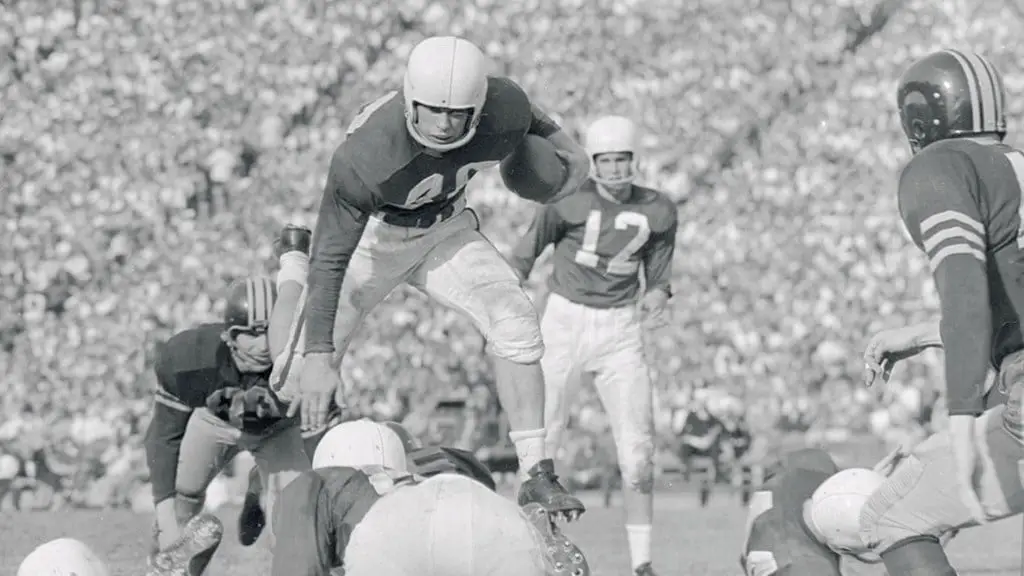
A Brief History of American Football
"Football" before the 19th century referred to any number of ball games played on foot. The rules of these games differed from one another, some allowing the use of hands “running games”, others forbidding it “kicking games”.
One legend has it that the football game rugby, American football’s ancestor, was invented when an Englishman grew tired of the no hands restriction, picked the ball up, and ran. Out of an interest to enforce the rules of the game the other players tackled the fellow. So much fun was this diversion that running football games were born. Whether this is true or not is unknown, but what is known is that football does have its origins in the games played by pre-colonial European peasants.
The first vestiges of what would become American football are found in the 19th century in the games played by students at the elite schools and universities of the United States. A particularly violent running game was played at Princeton University circa 1820, and around this time a kicking game was also being played by students of Dartmouth College. Rules for the Dartmouth game, known as “Old Division Football”, were published in 1871. The first running game to codify its rules was the popular English sport, rugby, and it did so in 1845.
The First Football Teams
While there is some degree of debate over what constitutes the first American football team, most sports historians point to the Oneida Football Club, a Boston club founded in 1861. Nobody knows what rules this club used; whether they played a running, kicking, or hybrid version of the game. It is also known that rugby was taking off in Canada around this time. The Montreal Football club formed in 1868 and is said to have played a variant of English rugby. This became the root of Canadian football, which is important here for it later had a large influence on American football’s development.
It is not clear what the rules and regulations most of these early football games followed. However, the infamous Rutgers v. Princeton game in 1869 opens a window to the past. The game was played by two teams of 25 people each. Each team was composed of 11 “fielders”, 12 “bulldogs”, and two “peanutters” whose job was to hang out near the opposing team’s goal so as to score from unguarded positions. This fact suggests there was no such thing as an “offside” rule at this time. American football at this point closely resembled soccer in the sense that a team scored goals instead of touchdowns and throwing or running with the ball was not allowed.
While the NFL states that this early game was indeed based on soccer and not rugby, it did begin intercollegiate football games. Four years later, Yale, Columbia, Princeton, and Rutgers codified the first ever set of intercollegiate rules for football. However, these rules forbade players from throwing the ball or running with it. It was soccer.
Beginning of College Football
It is Harvard we have to thank for American football. Harvard representatives knew in advance that the four schools above planned on codifying rules forbidding aggressive physical contact and the carrying of the ball, so they refused to attend. Harvard’s obstinacy on behalf of rugby led shortly thereafter to the McGill v. Harvard match of 1874 and the Harvard v. Yale game of 1875. Due to the popularity of these matches other US universities began to field rugby teams. Finally, in 1876 a meeting was held between Harvard, Columbia, Princeton, and Yale where England’s Rugby Union rules were adopted by all four schools, but with two key changes. No longer would the scoring of a touch down be nullified if the opposing team kicked a field goal.
Walter Camp is widely considered the father of modern American football. Between 1880 and 1883 this coach of the Yale football team came up with several major adjustments to the game: an eleven player team, a smaller field, and the scrimmage –a player handing the ball backward to begin the play. An even more important alteration, if the offensive team failed to gain five yards after three downs they were forced to surrender the ball. Camp also established the norm of a seven-man line, a quarterback, two halfbacks, and a fullback. Thanks to Walter Camp, football as we know it finally took shape.
The football field that players use has also undergone a series of changes throughout history. The field’s size has been changed from 120 yards, not including the field’s end zone areas on either side of the field, to a length of no more than 100 yards not including the end zone regions. The width of the football field has been regulated to 55 1/3 yards where at one time it was 100 yards wide. The very first footballs used in college football gaming were 23 inches in diameter at their widest point and they were shaped like an oval. Today’s footballs are prolate spherical balls measuring 20.75 inches around its widest part. In addition, at one time a touchdown in the game of football was worth a total of two points for a team and five points was earned for a field goal. The points applied changed too due to the evolution of the game and new regulations changing the points for a field goal to three and the points for a touchdown to six.
Football soon became popular among the general public, which in 1892 led to the sport becoming a source of income for outstanding players. On November 12, 1892 William Heffelinger, a Yale All-American guard, became the first professional football player. A Pittsburgh club paid him $500 to play against another Pittsburgh team. Three years later, the first all professional game was played in Pennsylvania between the Latrobe YMCA and the Jeannette Atheltic Club.
Player Deaths and Brutal Injuries
Over the next decade American football developed a reputation as a high injury and high mortality sport. Eighteen players were killed in 1905 alone. This was in part due to lack of protective gear and the use of interlocking defensive formations, as well as a tendency for teammates to drag ball-carrying players forward to gain extra yards. The year 1905 began a period of reform through which was developed a neutral zone between scrimmage lines. Furthermore, it was mandatory that six players from each team were positioned at this neutral zone. The forward pass, a distinct break from rugby and a signature of American football, was also legalized at this time.
However, these changes were not enough. In 1908 33 more players were killed on the field. Between 1910 and 12 interlocking formations were finally banned and more protective padding introduced, both these measures helped reduce the death and injury toll. Other changes made at this time included the addition of a fourth down, and the six point touchdown.
Professional Football Begins
It was not until 1920 that the first professional football league was established. Olympic athlete Jim Thorpe was elected president of the American Professional Football Association and its 11 teams all located in the Midwest. This body changed its name to the familiar National Football League (NFL) in 1921, the same year the league started to release official rankings. The early NFL was loose knit. Teams often came and went, and college football was still the dominant form of the game. However, as college football stars like Benny Friedman and Red Grange joined the professional game, pro football gained in popularity. An annual championship game was begun in 1933 and by 1934 almost every small town football team had moved to the city.
Professional football came to compete with college football for a fan base around the end of the Second World War. Games were higher scoring and faster paced, thanks to the development of the “T formation”, and the first West Coast team was established when the Cleveland Rams moved to LA. By 1950 professional football became one of America’s major sports. Television gave sports fans the opportunity to cheer for and against star players such as Paul Hornung, Johnny Unitas, and Bobby Layne. Surging popularity enabled football to expand into two leagues, but this experiment was short lived. In 1970 the AFL and NFL merged and formed two “conferences”, the American Football Conference, and the National Football Conference. Another result of this merger was the now wildly popular Super Bowl –most years rated the most watched television program in America. The year 1970 also founded another important American football institution, Monday Night Football.
Both college and professional football remain popular to this day, watched nation-wide by fans on Saturdays and Sundays respectively. Thanks to careful rule changes and additions over the years the game is now more fast-paced and less injurious to players than at any other point in its history. So popular, in fact, is American football among spectators that the game has spread across the globe to Mexico, Europe, and even Japan, where it continues to flourish and evolve.

